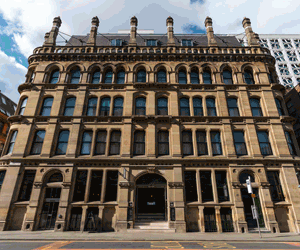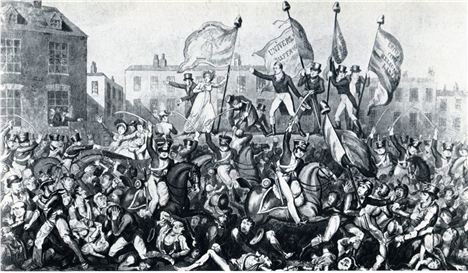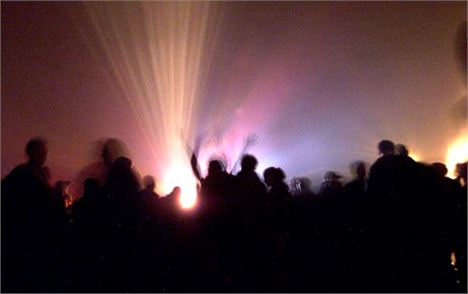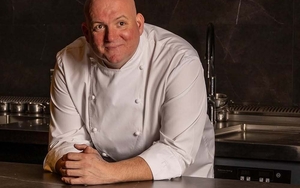THE Library Theatre has made a virtue of necessity by using their temporary semi-homeless status to create exciting and original site-specific productions. Manchester Sound: The Massacre, their third and final in the series, written by Polly Wiseman and directed by Paul Jepson, is currently in production at a secret city centre venue.
We assemble on a bit of grubby land and are eventually greeted by a tribe of youngsters determined to get us to join their party: that’s ‘PARTY’, pronounced Shameless-style.
The story brings together two real key events in the history of the city: the Peterloo Massacre of 1819, where a peaceful gathering of ordinary Mancunians demonstrating in favour of democracy were attacked by the authorities, leaving eighteen dead and hundreds injured. And 1989’s acid house and rave culture, where largely peaceful gatherings of ordinary Mancunians danced for hours demonstrating the right to party.
 Manchester Sound: The Massacre
Manchester Sound: The Massacre
I turn up at the Northern Quarter meeting place, curious and willing to find out more, yet not completely open-minded about attempts to link the two movements. We assemble on a bit of grubby land and are eventually greeted by a tribe of youngsters determined to get us to join their party: that’s ‘PARTY’, pronounced Shameless-style. We’re herded around the streets, and eventually taken to the ‘secret’ location, an old, empty building, where our hands are stamped and we’re ushered towards the rave. Some very basic dialogue sets the scene, but with a large part of the audience qualifying for bus passes the cast have a hard job to convince. It’s meant to replicate the buzz and excitement of heading out, destination unknown, expectations high, but it seems forced and it’s too long before much really happens.
The Peterloo story focuses on real characters, Middleton’s famous Sam Bamford and his wife Jemina along with nationally renowned Henry ‘Orator’ Hunt, the speaker for the rally. The rave culture characters are fictional, representative of the types found there: drug-pushing bouncers, easily influenced teenagers, DJs with a strong sense of their own importance, and a Liam from Middleton. There’s probably always a Liam from Middleton.
Some of the best parts of the show are when the characters meet across the years. There’s an entertaining scene where Middletonians, Liam and Sam, meet, Liam recalling Sam’s name from his trade-unionist father’s admiration, and another where politics student Evie gets a strong lesson in the fight for women’s rights. The scene where the nineteenth century women encounter the grubby and occasionally-flushing club conveniences and condom machine, highlights how much we take for granted today. Does this include the vote? It’s an issue not really explored.
The cast are impressive. All portray two characters, and the planning and back-up systems for costume changes, essential in supporting the actors’ ability to continually switch between the two, are vitally accurate.
Rachel Austin, who gave a stunning performance in the Royal Exchange Studio’s Black Roses, is superb in both her roles, the strong and loyal Jemima Bamford and the rather gullible teenager Allegra. Adam Fogerty is terrifying as police chief Joseph Nadin and as the thuggish bouncer, both able to enforce their own rules. We’ve all met Dean Fagan’s Liam. Many times.
The massacre scene is brilliantly chaotic, with strong input from movement director Lucy Hind.
Yet again I have the usual quibbles regarding site specific work. I found myself questioning whether the immediacy of performance was worth the traipsing around that promenade performance demands. There were a good few times when I just wanted to be in a seat looking at actors on a stage. At times I couldn’t see the actors, but when I could I was impressed. The action and the audience keep moving between floors, so a knee problem gave me the opportunity to test the disabled facilities, sharing a lift with a skilled mobility-scooter driver and a company member who efficiently ensured our safe arrival at the correct floor and provided ‘best-position’ hints.
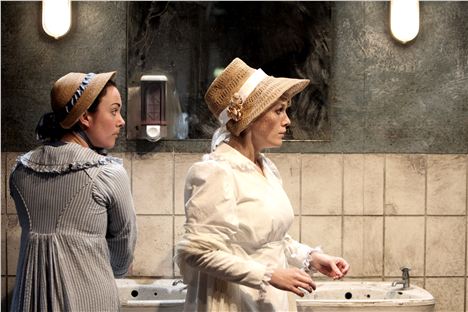 Manchester Sound: The Massacre
Manchester Sound: The Massacre
The evening is an interesting experience. Both stories have plenty of ideas to explore, but that’s not really achieved. Writer Polly Wiseman and director Paul Jepson have worked hard and produced something impressive, but I do feel that they decided the two events could be linked and then pulled people on board to support the thesis. Even historian Robert Poole, writing in the programme, claims “In both periods Britain enjoyed autocratic Tory governments pursuing scorched-earth free market policies, lifting the tax burden on wealth and property, whilst increasing it on the poor, and favouring big capital whilst removing legal protection from labour…….In both periods Manchester had reactionary police chiefs…”
I can agree. But this ignores the vote. The acid-house ravers had the vote, the Peterloo protestors did not and were actively engaged in campaigning for wider suffrage, some losing their lives to the cruel and cowardly power of the authorities.
We may not have perfected our democracy, but the difference can’t be ignored. It lies at the heart of the Peterloo tragedy, and at the heart of Manchester’s history.
It’s an interesting evening; performances and parts of the writing and direction are engaging. But the concept is flawed at a basic level, a basic flaw that Manchester, with its history of championing change, should recognise.
Manchester Sound: The Massacre, written by Polly Wiseman and directed by Paul Jepson, runs at a secret city centre venue between Saturday 8 June - Saturday 6 July 2013







